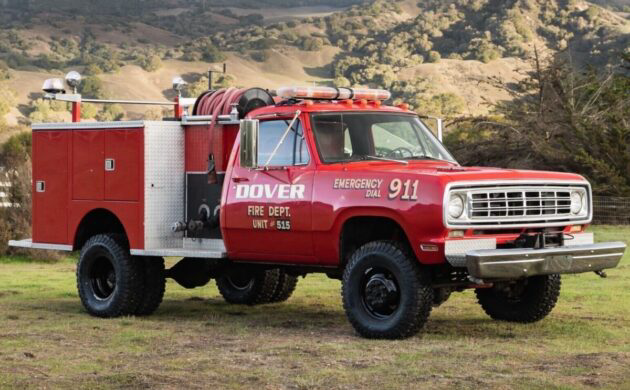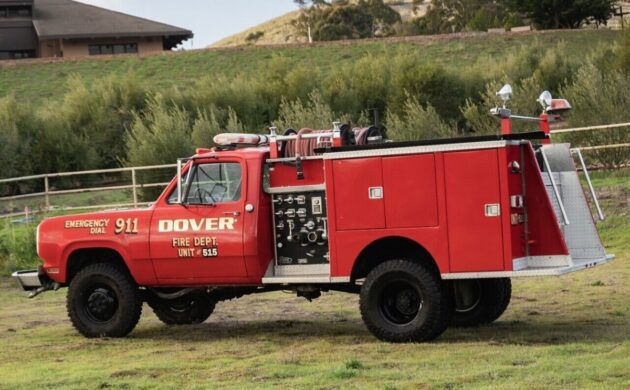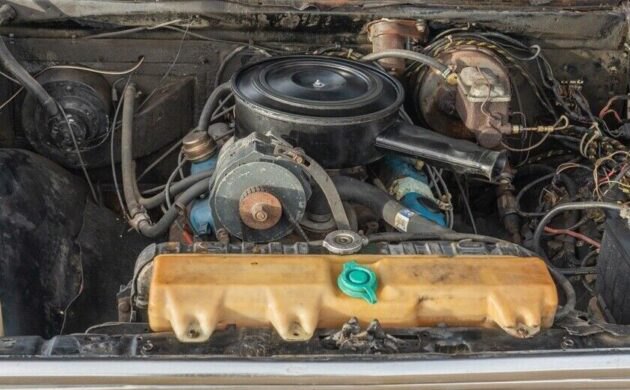I’ve always had a fascination with fire trucks ever since I was a kid, from those big monsters that fight the more serious blazes down to the smaller units that either tag along or just put out the not-so-large flames. The 1976 Dodge Power Wagon here on eBay would fall in the latter category, but that’s probably good for collectors because it won’t take up all that much room to store plus its days of being on call for emergencies are likely over anyway. If you’ve been in the market for something unusual, or maybe a cool parade or display vehicle, this one just might fit your needs. It’s in Salinas, California, with bidding having reached $10,100, but you’ll have to top that amount as the reserve has not been reached.
Although it now resides in The Golden State, the Dodge spent many of its years in the Bluegrass commonwealth and served the Dover, Kentucky Fire Department for most of its working days. We’re not told exactly when this one was retired from active duty, but the seller has owned it for about a year and says he bought it from a private collection, then began making some repairs such as cosmetic improvements. We don’t get any details as to what all that entailed, but the exterior and paint seem to be in fine shape overall and I’m not spotting any rust or corrosion anywhere on the outside.
The truck’s mileage is listed as 24,673, and for a responder-type vehicle, I’m guessing that may be actual. There’s no word on whether or not the engine has ever had a complete overhaul, but if the miles are correct it may not have needed any major work yet, although the seller mentions he has installed a new carburetor, fuel tank, and fuel pump. The transmission has been rebuilt with a new clutch also added, along with a fresh exhaust system. It’s also recently been lifted 3 inches with new wheels and tires all the way around.
Things are looking pretty good on the inside too, with both the seat and floor covering replaced not long ago, plus potential buyers will be glad to know that the radio, siren, and all the lights are working correctly. The actual fire-fighting equipment hasn’t been tested, but it’s all is said to appear complete and the tank does hold water. Who knows, maybe some municipality will spot this one and decide to return the truck to what it was made for, though I’m guessing the more likely scenario is a future showpiece in somebody’s collection. What are your thoughts on this Dodge Power Wagon Firetruck?





Minus the water apparatus,,,”EMERGENCY”,,one of the 3 Webb TV series. It was actually the most realistic of all his shows. Before paramedics, fire fighters arrived as 1st responders in these, to stabilize the injured, and then called for an ambulance. We’ve all had plenty of rain, it seems, and don’t hear the word “wildfire” much, but rest assured, summer will bake it dry again, and a truck like this could save the farm, it could. What’s THAT worth? Great find, I, in “Lonely Arms” Apartments, have no use for it, but I wouldn’t dawdle on this one.
Lots of wildfires up in Central to Northern Alberta, Canada right now. I heard it’s tinder dry and spring temperatures are way above normal. It’s an election year up there and skuttlebutt says that the fires were caused by global warming and the governing powers. All I know is that there is some evacuation going on for the first time in 7 years. There will no doubt be a few of these trucks deployed in the next few weeks. Lots of them still around in the rural regions of MT and AB…
I believe that you are referring to the fact that the truck used on the TV show wasn’t actually a “fire truck”. It has (it is currently on display at the LA County Fire Dept. Museum) a fully compartmented rescue style body. I do not believe that any fire fighting capability (pump, plumbing, hoses, etc.) exists on this apparatus (except extinguishers). As you indicated, this department pioneered fast-on-the-scene EMS type services with equipment like this. In larger jurisdictions today, an apparatus with a three-person or more member crew (one or more of which is likely an EMT/Paramedic) would roll on the calls depicted on the show, supported by specialized units as needed (heavy rescue, etc.), and, of course, an ambulance.
In the current wildfire era, IF this thing is still reliably operating and pumping, it would be perfect for a large ranch or farm situation, or a pocket of “off the grid” houses, especially one quite remote from regular fire response. I can think of any number of small settlements or large ranches out here in my part of Arizona that should consider buying such a rig. In most such places, any fire will completely consume a house or trailer, if not adjacent structures as well, before the firefighters can even show up. It’s actually likely that having such a rig, plus some minimal training to use it, could reduce the insurance costs of the owning ranch or “village” somewhat substantially, maybe even enough to pay for getting it.
The problem, of course, is having it available when it’s needed. That’s where you need a volunteer FD or trained ranch hands.
If one were to purchase this vehicle for active fire suppression, I would strongly suggest also investing in a 2,000 (2 axle) or 3,000 (3 axle) gallon water truck/water tender and a driver. The on board water supply on this apparatus (likely around 300 gallons or less- most larger wildland units carry 500-600 gallons, and even they are supported by tenders for fast refill), even using the most water conserving equipment and techniques, will not last you very long- possibly just long enough to threaten your life with a burn over if you are working by yourself. Without an adequate, readily available backup water supply (tanker, pond, pool, stock tank, portable tank, etc., you are likely not going to be able to do that much most of the time. You won’t put out a fully-involved house or barn fire with this by yourself (unless hooked to a hydrant, etc.). A small grass fire might work, but add in any wind- good luck. All that having been said, these units are typically used to hold things at bay initially until the bigger units arrive, so they have their best utility when backup is readily available.
Also, side hill stability and cornering/roll potential are considerations when going off road in a vehicle of this type. I’ve seen a lot of wrecked fire apparatus through the years. You can’t fight the fire if you never arrive…
Just my $.02 after 30 years in the fire apparatus industry. Stay safe out there.
(By the way, you can purchase a similar unit, except five years newer and lower miles (with some equipment included) for $7,500.00 on the Fire Rescue Trader website in Pennsylvania.)
This is actually a W400. I’ve got this trucks twin. Mine has 14000 miles, but not quite as pretty. It has a 300gpm 400psi pump and a 600gal tank. It’s got 2 2 1/2 inch suction and discharge hoses, and the small hose on the roll up top. Pump is connected to pto on transmission. I gave mine a much needed upgrade to hydro boost power brakes. Stops on a dime now. Also swapped the holey 2barrel for a thermoquad 4barrel. Runs much better and better fuel economy. One of the best things is the front mounted winch also connected to a pro on transmission. And one hell of an anchor in rear door to tie off with. Not as fancy as the new ones, but much tougher.
These were tough, reliable trucks, maybe not quite as durable as the original Power Wagons but they ran an awfully close 2nd. Rough riding as hell! I got my bell rung by the upper window frame when I hit my head while driving at speed down the highway and drove onto a bridge. But I don’t think you could work these trucks to death; you had to kill ’em with a stick. 4.88 gears were the order of the day and with 7.50 x 16 tires you were at 3500 rpm at 60 mph. But you seldom had to shift down, even when fully loaded.
That engine had a tendency to plug the exhaust passage through the intake manifold, necessitating the need to remove the intake and rod the heat-riser passage out every spring. You knew when you needed to do that because it took forever to warm it up on a cold morning when that passage became blocked.
I’m kind of surprised that this would have trouble with the transmission. I’d guess it to be an NP-435 which was a good transmission overall. I rebuilt lots of them over the years and they could be found in nearly everything but GM products back in the day. I had two trucks that ran them and both gave no trouble. Our W-300 and a couple of Ford 3/4 ton 4x4s on the ranch also had them. I had to replace the front seal in the Dodge but that was the extent of the work I did to that in over 140K miles.
Three inch lift? Seriously? On a W-300? Our shop installed a lot of lift kits over the years; primarily for clientelle that were marginally to completely size-challenged. I remember one customer getting out of his bone stock truck; he could’ve walked uprightly underneath it BEFORE he had the “enhancement device” installed. I swear his girlfriend all but had to lift him up into the truck after the job was done.
Our truck had a flatbed on it. Several others in the region were similarly equipped. If this came my direction the fire apparatus would be removed and sold, and a simple steel deck installed. Fifth wheel hitch and it would be used to haul things…
Remember when you were a kid and played fireman? Now is your chance to play as an adult. Be the first on your block with a real fire truck!
When I lived in west Texas, our fire department (only one since we were less than 10,000 people) purchased 3 similar to this one…. strictly for grass fires outside of town. The closest town to us was about 30 miles away, so it was up to our town to chase down those grass fires to keep them from getting to town. The oil companies that had pump heads in our area paid at least half the cost in case they needed help out in the fields. Fortunately in the time I lived there, they didn’t get a lot of use, but they were also used for small fires in town as well.
Awesome looking truck. I’ve always liked firetrucks, particularly those based on pickup trucks.
Always remember, when buying retired fire equipment, low miles, do not equate to low engine hours. And remember, most states require fire equipment to pass certifications, before they can be used for fighting fires off of your property.
Cool ranch brush fire truck. All I need is a ranch first if I bought it. Nice truck . I thought of the 70’s tv show Emergency too.Glwts.
As some of us have seen from fast moving range and forest fires literally close to home, as a fire suppression unit these are only as the crew manning them, ie, the carcass of the formerly privately owned hook and ladder truck in a nearby valley with no one trained to use the pump and hose-even if it was in working order.
On a lighter note, I’ll bet the “Emergency!” kids lunchbox on the front seat is a high dollar option with this sale😆.
All in all a clean well kept truck just waiting for the right “gotta havit!!” buyer.
We, in CA, are using the GM sister of this, equally old, more miles, but it runs, and pumps water, seats three, standard shift, and gas, not diesel, so CA lets it keep going where if it were diesel, as a private owner, you would be restricted to 1000 miles or 1000 hours/year as a “parade vehicle”. Useful for small issues, like an automobile accident, where EMT or just advanced first aid, are useful, as well as small engine or brake fires, and, in the event of big wildfires as one of many which can navigate narrow, rough, dirt roads where big firetrucks cannot go.
Ok the first thing I would do is remove the fire equipment and sell. Then add a camper to the rear, with storage compartments on both sides and a huge lithium battery bank on each side to go camping off grid, anywhere I wanted. The only drawback would be the dual rear wheels, that are limited on some beaches. But that’s all.
Rampart!! Emergency!!
Nice truck. If it has a 3″ lift it needed tho. It sits nice. 318 or 360? Obviously an LA motor. Not really like an EMT rig. Those make awesome campers. Nice truck, fair price but what would I do with it?? Not that it would matter to me
Most NFPA (National Fire Protection Association) – compliant fire apparatus are also equipped with hour meters, which are better indicators of total use. The pump on a unit this size (typically 250-350 gpm) usually runs off a PTO. Pumps on full sized pumpers (Type I and Type II engines in the USFS classification system) run off the truck’s transmission through a split driveline-transfer case arrangement. I’ve seen a number of older fire engines where the odometer kept racking up miles even as the apparatus was stationary and in “pump gear”. That is highly unlikely to be the case with this apparatus, although if used in “pump-and-roll” mode it would likely include those miles on the odometer.
If fire apparatus is used as part of an organized fire suppression unit (public fire department, private fire brigade, etc) then NFPA standards require that the pump, hose, ladders, etc must be tested and re-certified periodically. And there are hundreds of requirements for personnel training and certification, personal protective equipment, etc. However that does not mean that a farmer can’t voluntarily help a neighbor who has a combine on fire while waiting for units from the nearest fire station that is 20 – 30 minutes away. Just use common sense, don’t do anything foolish, and don’t try to be a hero. (If you search the internet there are some decent basic firefighting training videos presented by qualified fire service instructors that can watched on line for free.)